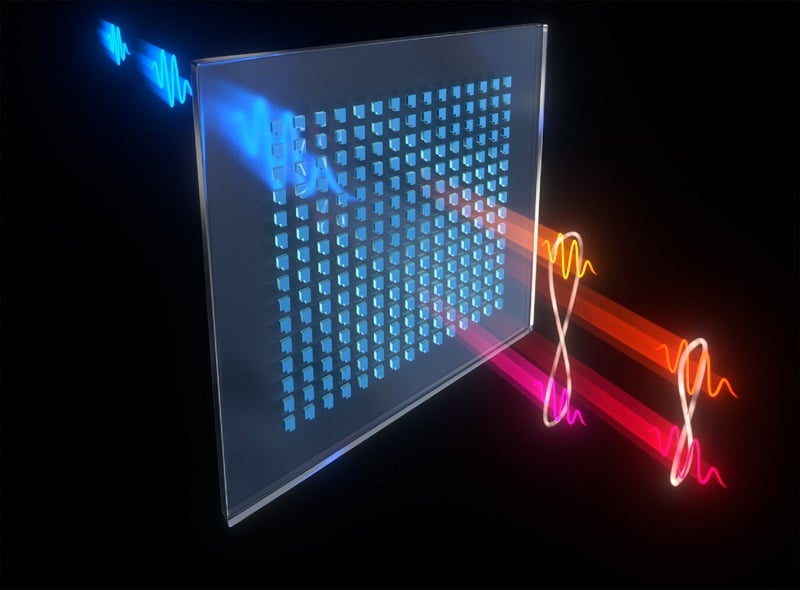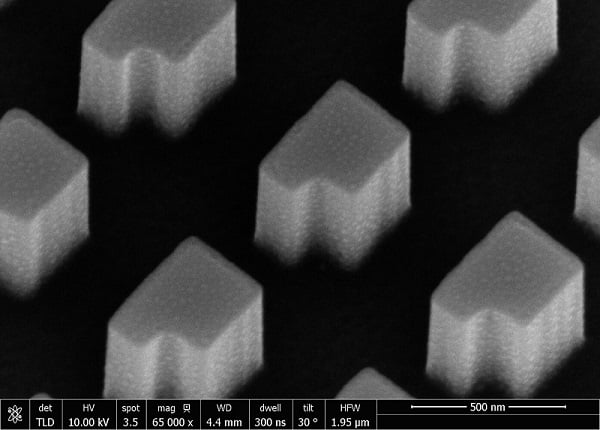
Metasurfaces Open Up Research Paths For Quantum State Engineering
Scientists from the Max Planck Institute for the Science of Light and the Friedrich-Alexander-Universität Erlangen-Nürnberg, in cooperation with Sandia National Laboratories, have pioneered a method of generating entangled photon pairs that overcomes some of the pitfalls of traditional methods of generation.
Traditionally, photon pairs have been generated using one of two nonlinear effects in bulk optical elements — spontaneous parametric down-conversion (SPDC) or spontaneous four-wave mixing (SFWM). The nonlinear effects cause one or two pump photons to spontaneously decay into a photon pair.

Pump photons pass through a resonant metasurface and produce entangled photon pairs at different wavelengths. Researchers created photon pairs at several different frequencies using resonant metasurfaces. The research addresses some of the pitfalls to existing methods that are used to produce photon pairs — one of the key requirements for quantum state engineering. Courtesy of Tomas Santiago-Cruz/Max Planck Institute for the Science of Light.
The problem is that these effects require strict momentum conservation for the involved photons. Any material the photons travel through have dispersion properties that prevent momentum conservation.
There are techniques that achieve the needed conservation, but they severely limit the versatility of the states in which the photon pairs can be produced. As a result, traditional optical elements like nonlinear crystals and waveguides can successfully produce photonic quantum states. But the uses for these crystals are limited and unwieldy.
Metasurfaces, which can have subwavelength thicknesses of a few hundred nanometers, are effectively 2D optics, which makes them much easier to handle than traditional optical devices. More importantly, their thin profile minimizes the momentum conservation of photons passing through them. This allows for multiple nonlinear and quantum processes to happen with comparably higher efficiencies and it opens the door for the use of many materials that would not work in traditional optical elements.
These qualities of metasurfaces have made them candidate sources of photon pairs for quantum experiments. Additionally, metasurfaces can simultaneously transform photons in several degrees of freedom, such as polarization, frequency, and path.

Scanning electron micrograph of a metasurface tested in the work. Resonances of the metasurface enhanced the rate of photon emission by several orders of magnitude compared to uniform sources of the same thickness. The newly introduced method for the generation of entangled photon pairs supports future research pursuits in quantum state engineering and, within it, the field of quantum optics. Courtesy of Tomas Santiago-Cruz/Max Planck Institute for the Science of Light.
Now, according to the researchers, photons of a certain wavelength can be paired with photons at two or more different wavelengths simultaneously. This allows creation of multiple links between photons of different colors. In addition, resonances of the metasurface enhance the rate of photon emission by several orders of magnitude compared to uniform sources of the same thickness.
“Metasurfaces are leading to a paradigm shift in quantum optics, combining ultrasmall sources of quantum light with far reaching possibilities for quantum state engineering,” said Tomas Santiago-Cruz of the Max Planck Institute for the Science of Light and Friedrich-Alexander-Universität Erlangen-Nürnberg.
The research was published in Science (www.doi.org/10.1126/science.abq8684).
Published: September 2022